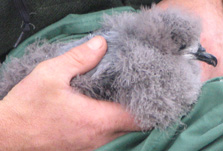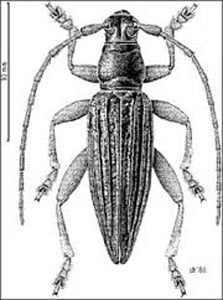Introduction
In the past, the Chatham Islands swarmed with animal life. But these species have declined since the arrival of humans.Animals of the Chatham Islands factsheet (PDF, 1,050K)
In the past, the Chatham Islands swarmed with animal life. Marine birds and mammals came ashore to breed or roost, bringing nutrients to enrich the soil. The forests were alive with bird and invertebrate life.
Waterways supported huge numbers of wetland birds and fish. The shore was a treasure trove of shellfish, crustaceans, fish and birds. Harvesting, large-scale clearance of vegetation (especially forest) for farming, and human-imported animals have taken a large toll on the wildlife.
Rats, mice, pigs, possums, hedgehogs, cats and dogs consumed innumerable indigenous animals and their food supplies. Cattle, sheep, goats, pigs, horses and possums have reduced the complex indigenous vegetation cover to scattered fragments. These animals are now controlled in most areas on the Chathams protected for conservation.
Mammals
Prior to human arrival, the only mammals at the Chatham Islands were marine creatures: seals, whales and dolphins. Seals and whales, formerly abundant, were hunted to near-extinction, especially during the nineteenth century, but they have made a comeback. The Chatham Islands are now rich in marine mammal diversity, with five seal and 25 whale and dolphin species reported around the islands. It is a stranding hot spot, among the top three places for strandings in New Zealand.
See Chatham Islands marine mammals
Birds

Chatham petrel chick, Pitt Island
Several bird species have become extinct since humans arrived at the Chatham Islands.
They include a penguin, a swan, a duck, several ducks, several flightless rails, a fernbird and a bellbird.
Surviving endemic sea birds include:
- Chatham Island tāiko
- Chatham Island oystercatcher/tōrea
- Chatham petrel/ranguru
- Toroa (northern royal albatross) which also breeds at Taiaroa Head near Dunedin
- Chatham Island shag and Pitt Island shag,
Surviving endemic land birds include:
- Chatham Island pigeon/parea
- Black robin
- Chatham Island tūī
- Chatham Island tomtit
- Chatham Island warbler
- Forbes' parakeet
None of these birds are common and recovery programmes are underway for the most threatened of them.
Many sea bird species are still quite common around the Chatham Islands. Buller's mollymawk, prions, skuas, sooty shearwaters, storm petrels and little blue penguins are most likely to be seen at sea. Around the coasts, those most frequently seen include black-backed gull, red-billed gull, white-fronted tern, shags and skuas. Banded dotterel and pipit are often on the shore too.

Parea (Chatham Island wood pigeon)
Te Whanga Lagoon and the freshwater lakes and swamps of Chatham Island provide extensive habitat for wetland birds. Most common are black swan, black shag, mallard and grey ducks, pūkeko, welcome swallow, pied stilt and various migratory waders. In open country (farmland, bracken and shrubland), introduced finches and songbirds are common, as are harrier, spur-winged plover and buff weka.
Weka, imported from Canterbury (where they are now extinct) around 1905, have proliferated to such an extent that they are regarded as something of a pest at times, and are also a favourite seasonal menu item.
Birds of the forests include kākāriki (red-crowned parakeet), parea, Chatham Island warbler and Chatham Island fantail. Chatham Island tūī and Chatham Island tomtit are now largely confined to Pitt Island. Tūī were successfullly translocated from Rangatira Island to the south-west Chathams in 2009.
Common skink
The common skink, an endemic Chatham species, is almost extinct on the main islands, but remains common on Mangere Island and Rangatira, as well as a few other outlying islands.
Invertebrates
Of around 800 species of insects described so far on the Chatham Islands, about 20 percent are endemic. In the past, the Chathams would have been absolutely bustling with invertebrates, nurtured in the nutrient-rich environment. Glimpses of this plenitude can be had at night on Rangatira, where in summer the forests swarm with spiders, cockroaches, weta and beetles.
Habitat destruction and introduced mammals have led to the loss of such invertebrate riches on the inhabited islands. On Chatham Island and Pitt Island, the most you are likely to encounter nowadays are great quantities of flies, orb-web spiders, and red admiral butterflies.

Pitt Island longhorn beetle
Threatened invertebrates of the Chatham Islands include the Rangatira spider, Chathams giant click beetle, giant stag beetle, soft speargrass weevil, Pitt Island longhorn, "Thotmus" weevil and giant stick insect. Most survive only on island refuges, whilst some are hanging on in forest reserves on the main islands.
Freshwater fish and frogs
Most freshwater fish in the Chatham Islands are indigenous. Only nine native freshwater fish have been recorded, in comparison to over 40 on the NZ mainland. They include the longfin and shortfin eels, redfin bully, common smelt and four galaxiid species - giant and banded kokopu, koaro and inanga.
The common smelt forms shoals in parts of the Te Whanga lagoon and juveniles of this species are captured as 'whitebait' along the western shore of the lagoon from December to February.
A new species of mudfish, the only endemic freshwater fish to the Chatham Islands, was recently discovered in 2001 and since then has been found in three southern tableland lakes and one stream.
Goldfish are the only known exotic fish on the Chatham Islands and they are limited to small ponds on private property. The Acclimatisation Society attempted to introduce trout a couple of times in the past, but these introductions were not successful.
Two exotic species of frog have recently been discovered on the Chatham Islands, the whistling frog and the larger southern bell frog. Both of these Australian frog species are widespread on the New Zealand mainland.